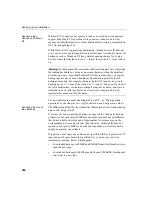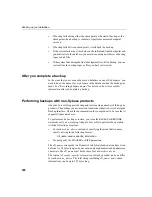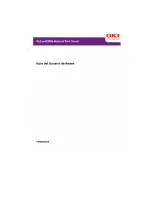
CHAPTER 11 Backup and Data Recovery
385
Backup file names for
backup to disk
BACKUP
always assigns file names to disk backup files by appending a suffix
to the archive_device name you specify. The suffix consists of “.” followed by
a number that increases by one for each new file. For example, if you specify
/iqback/mondayinc as the archive_device, the backup files are
/iqback/mondayinc.1, /iqback/mondayinc.2, and so on. This convention allows
you to store as large a backup as you need, while allowing you control over the
file size; see the
SIZE
option for details. Your file system must support long file
names to accommodate this convention.
You must make sure that the directory names you specify for the
archive_device exist.
BACKUP
does not create missing directories. If you try to
start a backup in a directory that does not exist, the backup fails.
You should avoid using relative pathnames to specify the location of disk files.
BACKUP
interprets the pathname as relative to the location where the server
was started, which you may not be able to identify with certainty when you do
a backup. Also, if there is data in other directories along the path, you may not
have enough room for the backup.
Positioning tape
devices
BACKUP
does not position tapes for you. You must position the tape
appropriately before starting your backup, and be sure that you do not
overwrite any of the backup if you use a rewinding tape device. For these
reasons, Sybase recommends you use a non-rewinding tape device. See the
operating system documentation for your platform for appropriate naming
conventions.
Specifying tape
devices on UNIX
Here are examples of how you specify non-rewinding tape devices on UNIX
platforms:
•
On Sun Solaris platforms, insert the letter n for “no rewind” after the
device name, for example, '/dev/rmt/0n'.
•
On IBM AIX platforms, use a decimal point followed by a number that
specifies the appropriate compression setting with rewind setting, for
example, '/dev/rmt0.1'.
•
On HP-UX platforms, use '0m' to specify the default tape mechanism and
'n' for “no rewind,” for example, '/dev/rmt/0mn'.
•
On DEC UNIX platforms, put an n in front of the device name, for
example, '/dev/nrmt0h'.
Warning!
If you misspell a tape device name and write a name that is not a
valid tape device on your system,
BACKUP
assumes it is a disk file.
Summary of Contents for Adaptive Server IQ 12.4.2
Page 1: ...Administration and Performance Guide Adaptive Server IQ 12 4 2 ...
Page 16: ...xvi ...
Page 20: ...Related documents xx ...
Page 40: ...Compatibility with earlier versions 20 ...
Page 118: ...Troubleshooting startup shutdown and connections 98 ...
Page 248: ...Importing data by replication 228 ...
Page 306: ...Integrity rules in the system tables 286 ...
Page 334: ...Cursors in transactions 314 ...
Page 396: ...Users and permissions in the system tables 376 ...
Page 438: ...Determining your data backup and recovery strategy 418 ...
Page 484: ...Network performance 464 ...
Page 500: ...System utilities to monitor CPU use 480 ...
Page 514: ...Characteristics of Open Client and jConnect connections 494 ...
Page 536: ...Index 516 ...
















































